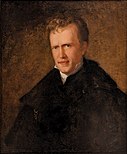User:Gerald Hogan
I welcome you to my user page. I've been a Wikipedian since June 2007.
Before you continue

To contact me, go to my talk page, or for private matters, email me.
Three recent changes
List of abbreviations (help):
- D
- Edit made at Wikidata
- r
- Edit flagged by ORES
- N
- New page
- m
- Minor edit
- b
- Bot edit
- (±123)
- Page byte size change
18 December 2024
- diffhist m Talk:Thomas B. Murray 07:12 +74 Jevansen talk contribs (add to WP:US State Legislatures) Tag: AWB
- diffhist m Talk:Robert E. Behnke 07:12 +74 Jevansen talk contribs (add to WP:US State Legislatures) Tag: AWB
- diffhist Bernadotte 07:12 +104 Gotitbro talk contribs Tags: Visual edit Mobile edit Mobile web edit Advanced mobile edit
My directory User:Harryboyles/Directory
Maintenance templates
Community portal tasks
You can help improve the articles listed below! This list updates frequently, so check back here for more tasks to try. (See Wikipedia:Maintenance or the Task Center for further information.)
Help counter systemic bias by creating new articles on important women.
Help improve popular pages, especially those of low quality.
Active Wiki Fixup Projects - - - Resources for maintenance and collaboration
|
"Wikipedia:Motto of the day/December 18, 2024"
Favourite mottos
A series of volcanic eruptions has been ongoing in the Reykjanes Peninsula, near the town of Grindavík, Iceland, since 18 December 2023. The eruptions, of which there have been seven so far, began after an intense series of earthquakes in November 2023. Although localised, seismic and volcanic activity has caused significant disruption across the western part of the peninsula, especially for the town of Grindavík. This Icelandic Meteorological Office photograph, taken on 18 December 2023, shows the first eruption in the series, in the Sundhnúksgígar crater chain.
Photograph credit: Icelandic Meteorological OfficeAmerican Writers is an 1824–25 work of literary criticism by American writer and critic John Neal (pictured). Published by Blackwood's Edinburgh Magazine, it is the first history of American literature and the first substantial work of criticism concerning US authors. Using no reference materials, Neal made incorrect assertions about many of the more than 120 authors covered. Scholars nevertheless praise the staying power of his opinions, many reflected by critics decades later. Neal also argued American literature relied too much on British precedent and had failed to develop its own voice. Neal wrote the series in London under the English pseudonym of "Carter Holmes", which convinced few. American Writers was well received in the UK but drew considerable ire in the US, particularly from William Lloyd Garrison. Neal was met with hostility and a fistfight on an 1827 visit to his hometown of Portland, Maine; he relocated there and remained until his death forty-nine years later. (Full article...)
Appendix














